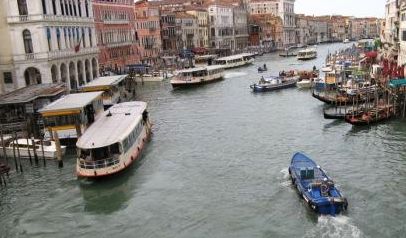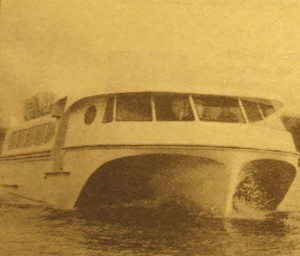
Every time I tell an arriving friend that a single ride on the vaporetto here is going to cost 7 euros ($9.26), I stifle a shriek. Though if I were to let myself shriek, it might cover the sound of my friend’s shriek. Or gasp. Or disbelieving laugh.
Why vocalize at all? Because the city covers roughly a mere four square miles (ten square kilometers), and while ten dollars may not seem unreasonable if you want to travel the length of the Grand Canal on the faithful #1 from Piazzale Roma on to the end of the line at the Lido (apart from the crushing crowds, it could qualify as one of the cheaper scenic boat tours in the world, I guess), it seems a demented price if you only need to go four or five stops.
For the record, I have done some calculations, and the average distance between stops is 1,141 feet (348 meters). The time involved in each leg is usually around five minutes. If you only need to go a few stops, the price comes to a lot per minute. It’s true that you can often reach your destination faster on foot, but not if you’re lost, and dragging suitcases the size and weight of the foundation stones of the Great Ziggurat of Babylon.
Note to readers: There are unlimited-ride tickets available for specified lengths of time for much less per ride, but that’s beside my point.
Returning to my point: The cost of public transportation in the most-beautiful-city-in-the-world. It wasn’t always thus, back when there were more residents than tourists. But over the years, although the number of residents has fallen, the number of tourists has risen which, according to my primitive notion of economics, ought to mean that the price of a ticket should shrink. Silly me.
“We have no money” remains the one-size-fits-all justification given by the ACTV, the transport company, for anything it does or doesn’t do; it has adopted this motto from the city government as a whole (note: the city is a part shareholder in the ACTV).
But why do we have no money? One reason could be the effect of the thieving ticket-sellers; there was a lively period in which sticky-fingered employees were turning up all over, discovered selling tickets worth a fraction of the price they charged for them and pocketing the difference, or counterfeiting tickets (back in the paper-ticket days), or other simple little dodges that worked surprisingly well for a surprisingly long time, taking home what amounted to multiple thousands of euros.
Another reason for the belt-tightening which was given in the somewhat distant past (and my favorite): “Do you have any idea what a can of paint costs?” Visions pass through my mind of surging oceans of paint upon which little bits of tickets are floating.
But a new glimpse of why they have no money may be discerned in a recent series of detailed articles in the Gazzettino, and the reason is the simplest of all: The ACTV has no money because they’ve spent way too much of it, particularly on failed conveyances.

There was the revolutionary vaporetto dubbed the “Mangia-onde” (or Waves-Eater, a nice, Norse-saga sort of nickname) which was going to banish waves and make their destructive effects a fading memory. It was built by the M Ship Co, of San Diego, California. One craft was bought and came to Venice in 1999 to great fanfare and trailing clouds of glory and the promise of the salvation of the city from motondoso.
But it was too good to be true. Not because it created waves, but because it created problems. For example, it wasn’t adapted to lagoon conditions (I take that to mean it was unstable); it didn’t pass under the bridges, such as the Ponte delle Guglie, and also the hull wasn’t fireproof.
The Mangia-onde was taken to a shipyard in Castello where it sat, abandoned, for 13 years. A few weeks ago this once-proud herald of the future, which had cost 900,000,000 lire (464,811 euros, or $651,061) was sold to a private buyer for 20,000 euros ($26,465). Without the motor. Nobody seems to know what happened to it.
The current director of the ACTV, Maurizio Castagna, was also director in the late Nineties. He explained that the boat was put aside because “It didn’t meet the standards of the Italian Naval Registry, and also because of a series of onerous (that means “expensive”) maintenance interventions and adaptations of the boat to the lagoon area.” One certainly couldn’t be expected to know what the legal nautical standards were (I’m thinking of the fireproofing), or what characteristics a boat has to have in order to putter around the lagoon, especially if you’re in the aquatic transportation business. So that was that.
Bonus digression: The saga of the bargain ferryboat a few years back. Just more of the same old from the ACTV.
There is now the “Sandra Z.” to consider, a motonave which the Gazzettino has dubbed the “latest ‘hole in the water’ of the ACTV.” She too was built and unveiled to great pomp in 1999, and since 2006 she too has been nestling in mothballs.

She was built (in Messina, curiously, not at a Venetian shipyard, but let’s not get distracted) to carry 1,200 passengers — the perfect vehicle for the pilgrims traveling around Italy in the Jubilee year of 2000 (who never materialized, in Venice, anyway). But even if they had shown up, they’d have had to start a new round of prayers and supplications after climbing aboard.
The system of propulsion created serious problems of maneuverability. The “Schottel” (name of its German company) enables the propellers to work at 360 degrees, which — says the Gazzettino — transformed the ship into a sort of spinning top that couldn’t be managed by its captains, not to mention the unpleasant effect on the passengers.
I am not qualified to make any judgment on the qualities of this propulsion system; I have no doubt that it is excellent in many situations. Just not on a motonave. Which couldn’t have been tested, it seems, before it was too late.
Four months after its launch, it ran into the wall at the cemetery island of San Michele (four injured); not long after, it ran into the dock at Punta Sabbioni. The electronic system went crackerdogs. Finally, in July, 2002, the “Sandra Z.,” pulling away from the Ponte della Paglia by the Doge’s Palace, caused two gondolas to run into each other and their passengers ended up in the drink.
She kept on randomly running into docks until 2006, when the ACTV tied her up and turned her into a floating storehouse.
Cost: 7 miliards of the old lire (4,000,000 euro, or $5,293,000).
“No ghe xe schei.” We have no money. I begin to see why. And I begin to see why vaporetto tickets have to paid for with small gold ingots.

1 Comment
I certainly share your horror at the vap prices, and every time we have visitors I feel somehow responsible for them burning up money. However, it has to be said that a single zone ticket on the London Tube now costs 5,50 Pounds (7,30 US) and let’s face it – being underground in (big) London is not at all as pretty as being overwater in (small) Venice. Same sardine-tin crowds, however.
Better to bike in London, walk in Venice and leave the American-family- refrigerator-sized suitcase at home….